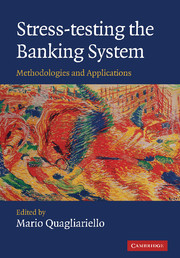Book contents
- Frontmatter
- Contents
- List of figures
- List of tables
- List of boxes
- List of contributors
- Foreword
- Acknowledgements
- Introduction
- Part I Fundamentals
- 1 A framework for assessing financial stability
- 2 Macroeconomic stress-testing: definitions and main components
- 3 Macroeconomic stress-testing banks: a survey of methodologies
- 4 Scenario design and calibration
- 5 Risk aggregation and economic capital
- 6 Data needs for stress-testing
- 7 Use of macro stress tests in policy-making
- Part II Applications
- Conclusions
- Index
- References
1 - A framework for assessing financial stability
from Part I - Fundamentals
Published online by Cambridge University Press: 18 December 2009
- Frontmatter
- Contents
- List of figures
- List of tables
- List of boxes
- List of contributors
- Foreword
- Acknowledgements
- Introduction
- Part I Fundamentals
- 1 A framework for assessing financial stability
- 2 Macroeconomic stress-testing: definitions and main components
- 3 Macroeconomic stress-testing banks: a survey of methodologies
- 4 Scenario design and calibration
- 5 Risk aggregation and economic capital
- 6 Data needs for stress-testing
- 7 Use of macro stress tests in policy-making
- Part II Applications
- Conclusions
- Index
- References
Summary
Introduction
In recent years, policy-makers and banking supervisory authorities reinforced their efforts aimed at ensuring financial stability, considering it as a relevant policy objective, autonomous with respect to both monetary and microeconomic stability (see Schinasi, 2003). Many central banks regularly publish reports in which they disclose their assessment of the factors that may threaten financial stability. Ad hoc fora have been established in order to discuss the implications for financial stability of globalisation, financial innovation and macroeconomic fluctuations. Major financial institutions also devote a large part of their activity to the analysis of the vulnerabilities of financial systems.
However, as pointed out by Schinasi (2005), ‘compared with the analysis of monetary and macroeconomic stability, the analysis of financial stability is still in its infancy. As anyone who has tried to define financial stability knows, there is as yet no widely accepted model or analytical framework for assessing or measuring it.’
The definition of financial stability itself is difficult to provide. Padoa-Schioppa (2003) considers financial stability as: ‘a condition whereby the financial system is able to withstand shocks without giving way to cumulative processes, which impair the allocation of savings to investment opportunities and the processing of payments in the economy’. Financial stability does not necessarily imply that all components of the financial system operate at or near peak at all times, but a stable financial system has the ability to limit and resolve existing imbalances (Schinasi, 2005).
- Type
- Chapter
- Information
- Stress-testing the Banking SystemMethodologies and Applications, pp. 7 - 17Publisher: Cambridge University PressPrint publication year: 2009

